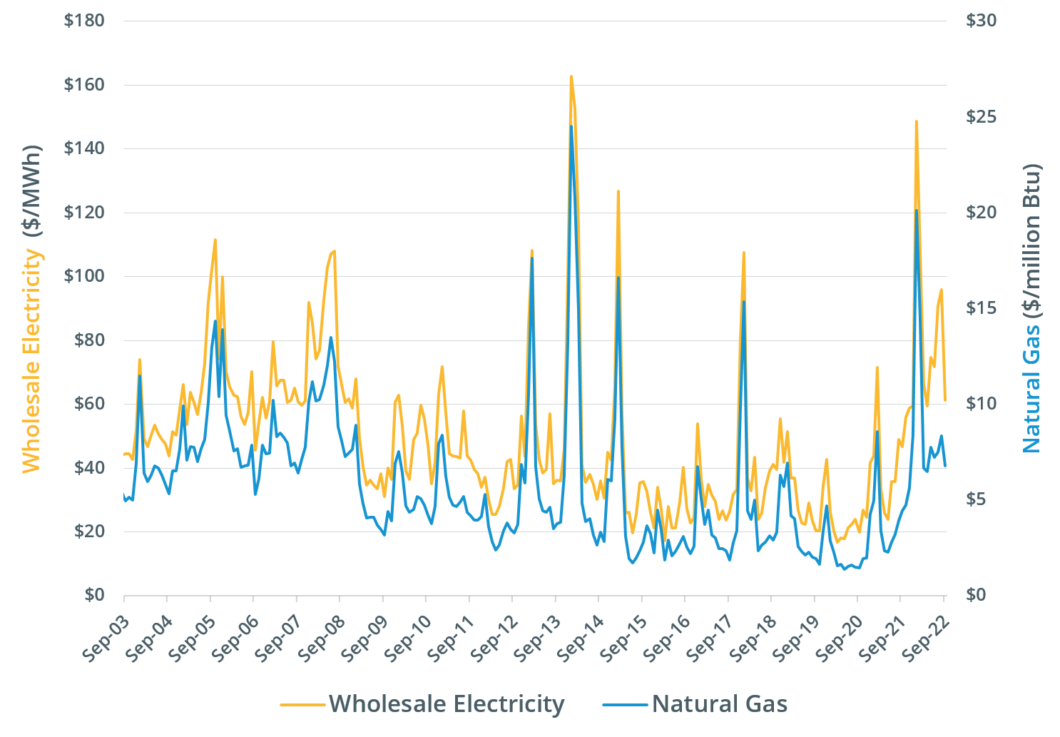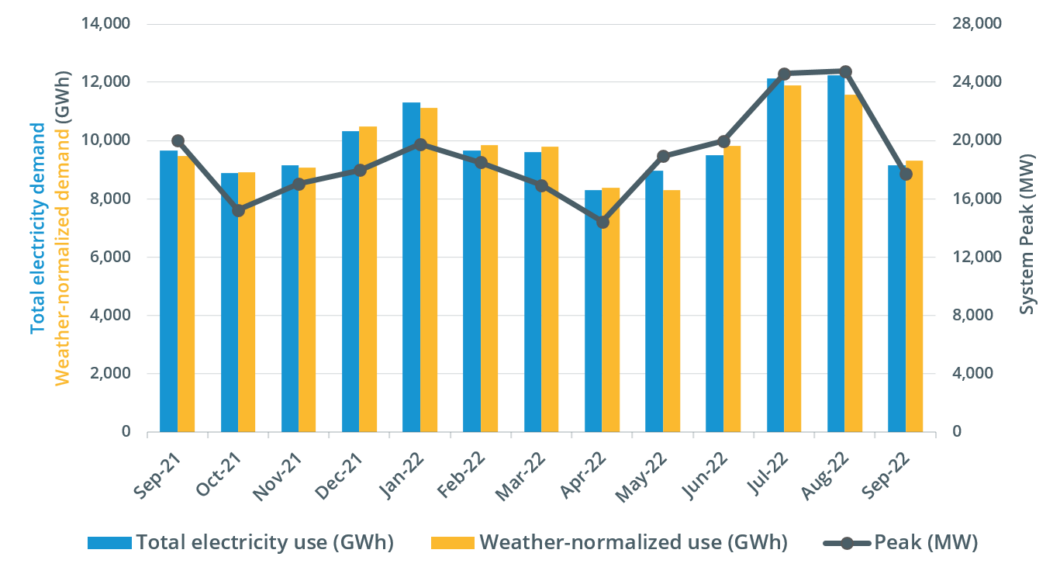Monthly wholesale electricity prices and demand in New England, September 2022
Wholesale power prices averaged $61.38 per megawatt-hour (MWh)1 in the Real-Time Energy Market in September 2022, up 31% compared to the previous year. Day-Ahead Energy Market averages rose to $67.23/MWh, a 40% increase from September 2021.
By the numbers
| September 2022 and Percent Change from September 2021 and August 2022 | September 2022 | September 2021 | August 2022 |
| Average Real-Time Electricity Price ($/megawatt-hour) | $61.38 | 31.3% | -36.1% |
| Average Natural Gas Price ($/MMBtu) | $6.79 | 53.3% | -18.9% |
| Peak Demand | 17,738 MW | -11.5% | -28.4% |
| Total Electricity Use | 9,141 GWh | -5.3% | -25.4% |
| Weather-Normalized Use2 | 9,320 GWh | -1.5% | -19.5% |
Drivers of wholesale electricity prices
In general, the two main drivers of wholesale electricity prices in New England are the cost of fuel used to produce electricity and consumer demand.
Power plant fuel
Fuel is typically one of the major input costs in producing electricity. Natural gas is the predominant fuel in New England, used to generate 53% of the power produced in 2021 by New England’s power plants, and natural gas-fired power plants usually set the price of wholesale electricity in the region. As a result, average wholesale electricity prices are closely linked to natural gas prices.
The average natural gas price during September was $6.79 per million British thermal units (MMBtu)3. The price was up 53% from the September 2021 average Massachusetts natural gas index price of $4.43/MMBtu. The Mass. index price is a volume-weighted average of trades at four natural gas delivery points in Massachusetts, including two Algonquin points, the Tennessee Gas Pipeline, and the Dracut Interconnect.
September wholesale electricity and natural gas prices

Electricity demand
Demand is driven primarily by weather, as well as economic factors. Energy usage during September decreased 5.3% to 9,141 GWh from the 9,648 GWh used in September 2021. The average temperature during September was 64˚ Fahrenheit (F) in New England, down 2˚ from the previous September. The average dewpoint, a measure of humidity, was 54˚F in September, down 4˚ from the previous September. There were 22 cooling degree days4 (CDD) during September, while the normal number of CDD in September is 34 in New England. In September 2021, there were 43 CDD. There were 86 heating degree days (HDD) during September, while the normal number of HDD in September is 96 in New England.
Consumer demand for electricity for the month peaked on September 12 during the hour from 5 to 6 p.m., when the temperature in New England was 76°F and the dewpoint was 66°. Demand reached 17,738 MW. The September 2022 peak was 11.5% lower than the September 2021 peak of 20,032 MW, set during the hour from 4 to 5 p.m. on September 15, when the temperature was 82°F and the dewpoint was 69°.
Peak demand is driven by weather, which drives the use of heating and air conditioning equipment. The all-time high winter peak was 22,818 MW, recorded during a cold snap in January 2004 when the temperature was -1°F and the dewpoint was -20°. The all-time peak demand in New England was 28,130 MW, recorded during an August 2006 heat wave, when the temperature was 94°F and the dewpoint was 74°. Air conditioning use is far more widespread than electric heating in New England, so weather tends to have a relatively greater impact on the summer peak than the winter peak.
September monthly peak demand and total and weather-normalized energy use

Fuel mix
The mix of resources used in any given time period depends on price and availability, as well as supplemental resource commitments needed to ensure system stability. Natural gas-fired and nuclear generation produced about 83% of the 8,528 GWh of electric energy generated within New England during September, at about 55% and 28%, respectively. Renewable resources generated about 11% of the energy produced within New England, including 4.4% from wood, refuse, and landfill gas; 2.9% from wind; and 3.9% from solar resources. Hydroelectric resources generated 5.4%. Oil-fired resources generated 0.1%. The region also received net imports of about 728 GWh of electricity from neighboring regions.
September generation in New England, by fuel source

The mix of resources used to produce the region’s electricity is a key driver of carbon dioxide (CO2) emissions. The ISO estimates these emissions through an analysis that blends data on electricity generation by fuel type with an emissions factor for each fuel that is based on data from the Environmental Protection Agency.
September estimated CO2 emissions in New England, by fuel source (metric tons)

CO2 emissions fell 6.6% year over year in September 2022, with New England power plants producing an estimated 2.4 million metric tons of CO2.
Estimated CO2 emissions from natural gas-fired plants—typically the largest source of emissions, due to the significant amount of power these resources produce—fell 3% year over year, from 1.95 million metric tons to 1.89 million metric tons, and accounted for 78% of the region’s estimated emissions.
Oil-fired resources produced an estimated 7,610 metric tons of CO2, a year-over-year increase of 9%. These resources accounted for 0.3% of the region’s total estimated CO2 emissions. Coal-fired resources produced an estimated 379 metric tons of CO2, about 0.02% of the region’s total and a year-over-year decrease of 41%.
CO2 emissions from other resources—mostly refuse and wood—were estimated at 535,670 metric tons in September 2022, down 18% from 655,343 metric tons last year. These resources accounted for 22% of the region’s estimated CO2 emissions for the month.
1One megawatt (MW) of electricity can serve about 750 to 1,000 average homes in New England. A megawatt-hour (MWh) of electricity can serve about 1,000 homes for one hour. One gigawatt-hour (GWh) can serve about 1 million homes for one hour.
2Weather-normalized demand indicates how much electricity would have been consumed if the weather had been the same as the average weather over the last 20 years.
3A British thermal unit (Btu) is used to describe the heat value of fuels, providing a uniform standard for comparing different fuels. One million British thermal units are shown as MMBtu.
4A degree day is a measure of heating or cooling. A zero degree day occurs when no heating or cooling is required; as temperatures drop, more heating days are recorded; when temperatures rise, more cooling days are recorded. The base point for measuring degree days is 65 degrees. Each degree of a day’s mean temperature that is above 65 degrees is counted as one cooling degree day, while each degree of a day’s mean temperature that is below 65 degrees is counted as one heating degree day. A day’s mean temperature of 90 degrees equals 25 cooling degree days, while a day’s mean temperature of 45 degrees equals 20 heating degree days.

Historical weather data provided by DTN, LLC.; Underlying natural gas data furnished by ICE.
- Categories
- Inside ISO New England
- Tags
- monthly prices, natural gas, wholesale markets
